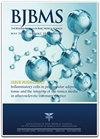嫌色肾细胞癌小细胞变异:10例临床病理及分子遗传学分析
IF 3.4
4区 医学
Q2 MEDICINE, RESEARCH & EXPERIMENTAL
引用次数: 4
摘要
憎色性肾细胞癌(ChRCC)的形态学多样性是众所周知的。除了典型的形态外,还描述了色素腺瘤样,多囊和乳头状模式。采用形态学参数、免疫组织化学和新一代测序技术对10例不同百分比的小细胞群体组成的CHRCC进行分析。患者男5名,女5名,年龄40 ~ 78岁。肿瘤大小为2.2 ~ 11cm,平均5.17 cm。小细胞成分占肿瘤体积的10 - 80%,其余由典型ChRCC形态的细胞组成。小细胞组分的免疫组化谱与典型的ChRCC免疫表型一致,CD117和CK7阳性。神经内分泌指标为阴性。发现了13个基因突变:DCIER1、FGFR3、JAK3、SUFO、FAM46C、FANCG、MET、PLCG2、APC、POLE、EPICAM、MUTYH和AR。然而,只有PLCG2突变被认为是致病的。ChRCC的小细胞变异进一步突出和扩展了现有的形态异质性谱。在存在“经典”CHRCC成分的肿瘤中,识别CHRCC的小细胞变体没有问题。然而,在有限的材料(即核心活检)中,这可能会带来诊断挑战。根据有限的随访数据,小细胞肿瘤成分似乎对预后没有影响,因为没有记录的侵袭性行为。认识到这种不寻常的模式,并应用额外的切片来寻找ChRCC的经典形态,以及通过免疫组织化学排除神经内分泌性质,可能有助于解决疑难病例。本文章由计算机程序翻译,如有差异,请以英文原文为准。
Small cell variant of chromophobe renal cell carcinoma: Clinicopathologic and molecular-genetic analysis of 10 cases
The morphologic diversity of chromophobe renal cell carcinoma (ChRCC) is well-known. Aside from typical morphology, pigmented adenomatoid, multicystic, and papillary patterns have been described. Ten cases of CHRCC composed of small-cell population in various percentages were analyzed, using morphologic parameters, immunohistochemistry, and next-generation sequencing testing. Patients were five males and five females, with age ranging from 40 to 78 years. The size of tumors ranged from 2.2 cm to 11 cm (mean 5.17 cm). Small-cell component comprised 10 to 80% of the tumor volume, while the remaining was formed by cells with classic ChRCC morphology. The immunohistochemical profile of the small-cell component was consistent with typical ChRCC immunophenotype, with CD117 and CK7 positivity. Neuroendocrine markers were negative. Mutations of 13 genes were found: DCIER1, FGFR3, JAK3, SUFO, FAM46C, FANCG, MET, PLCG2, APC, POLE, EPICAM, MUTYH, and AR. However, only the PLCG2 mutation is considered pathogenic. The small-cell variant of ChRCC further highlights and expands on existing morphologic heterogeneity spectrum. Recognition of small-cell variant of CHRCC is not problematic in tumors, where the “classic” CHRCC component is present. However, in limited material (i.e., core biopsy), this may present a diagnostic challenge. Based on the limited follow-up data available, it appears that the small-cell tumor component had no impact on prognosis, since there was no aggressive behavior documented. Awareness of this unusual pattern and applying additional sections to find classic morphology of ChRCC, as well as excluding neuroendocrine nature by immunohistochemistry, may help resolve difficult cases.
求助全文
通过发布文献求助,成功后即可免费获取论文全文。
去求助
来源期刊

Bosnian journal of basic medical sciences
医学-医学:研究与实验
CiteScore
7.40
自引率
5.90%
发文量
98
审稿时长
35 days
期刊介绍:
The Bosnian Journal of Basic Medical Sciences (BJBMS) is an international, English-language, peer reviewed journal, publishing original articles from different disciplines of basic medical sciences. BJBMS welcomes original research and comprehensive reviews as well as short research communications in the field of biochemistry, genetics, immunology, microbiology, pathology, pharmacology, pharmaceutical sciences and physiology.
 求助内容:
求助内容: 应助结果提醒方式:
应助结果提醒方式:


